Brendan Coates and Nghi Luu1
China today dominates many of the world's commodity markets. Its demand for commodities rose dramatically in the years leading up to the Global Financial Crisis, held up well during the crisis as prices fell, and continued to rise post-crisis. The pace of economic development, and processes of industrialisation, urbanisation, and rising per capita incomes, has seen China become a major commodity consumer on global markets, particularly in metals and energy.
This paper analyses the history of China's demand for commodities — across energy, metals and agriculture — and the potential path of future demand. It compares China's experience in recent decades with that of other recent industrialising economies, and considers the scale and pace of China's commodity demand and its own domestic production on global commodity markets. The long term outlook for Chinese commodity demand remains strong as the underlying drivers of Chinese commodity demand still have some time to run. China's per capita consumption of key commodities, like per capita income, is still well below that of major advanced economies. Moreover, given the scale of China's appetite for commodities, small shifts in its domestic demand-supply balance could have major implications for global commodity markets.
Introduction
Since economic reforms began in 1978, China has experienced an unprecedented phase of industrialisation and economic development. Annual economic growth of around 10 per cent over the past 30 years has centred on a development model that is heavily reliant on investment, which has helped accelerate the structural processes of industrialisation, urbanisation and motorisation.
To cater to the demands of rising incomes, and to meet its growing infrastructure needs, China's demand for commodities has risen rapidly in recent decades, and accelerated since 2000. As well as being a substantial source of global commodity demand, China is also a substantial global commodity producer, with significant domestic reserves of many commodities such as coal and iron ore, and the world's largest producer of wheat and rice. Nonetheless, production has not kept pace with the surge in demand, leading China to source an increasing share of its commodity needs on global markets.
Future Chinese commodity demand and supply will be heavily influenced by the trajectory of Chinese economic policy, particularly measures to transition towards sustainable growth with a greater focus on domestic consumption, rather than exports and investment, as the source of gross domestic product (GDP) growth. China has also demonstrated a strong commitment to reduce its energy intensity, by placing a high priority on energy conservation and environmental protection.
China's effect on global commodity markets in recent years has been magnified by delays in the global supply response for many commodities. The sheer magnitude of the pick-up in demand for commodities at the beginning of the last decade, particularly for China and other emerging economies, was largely unforeseen. This unanticipated increase in demand placed considerable pressure on global commodity supplies, which struggled to keep pace with rising demand.
The weakness in the commodity supply response seen in recent years has its roots in the low commodity prices of the late 1980s and 1990s. Low prices led to reduced global investment in research and development, exploration and production. The strong prices of the mid-2000s generated a supply response but it came with a significant lag as producers responded to higher prices only after the trend in prices had become firmly entrenched.2 Similarly in agricultural markets, growth in production has slowed since the late 1980s, with growth in both yields and the land area devoted to crops declining significantly. The lack of new investment in agriculture reflects, until recently, the multi-decade decline in the real prices of agricultural output (Coates, Devlin and Woods, 2011).3
The paper is structured as follows. The first section briefly discusses China's economic development over the past three decades. The subsequent three sections cover trends in Chinese demand, supply and global trade for energy, metals and agricultural commodities. It also compares China's experience in recent decades with that of other recently industrialised economies.
China's economic development, industrialisation and urbanisation
China's remarkable growth over the past 30 years has meant that its economy has doubled in size every seven to eight years. It now accounts for almost 15 per cent of global GDP on a purchasing power parity (PPP) basis and has accounted for almost 70 per cent of the increase in the weight of emerging market economies in global GDP since 1990 (Chart 1). Investment has been a key driver of China's growth, particularly over the past decade, and now accounts for nearly 50 per cent of GDP.
Rapid economic development has spurred rising per capita incomes for Chinese citizens. At the start of the reform period, China's GDP per capita (on a PPP basis) stood at around 2 per cent of that of the United States (US) (less than India, Vietnam, Laos and many other emerging Asian economies). More than 30 years later, in 2011, that share has grown to around 17 per cent. In another five years, the International Monetary Fund (IMF) projects that China's GDP per capita will be close to one-quarter of that of the US and around a similar level to where Korea was in the early 1990s (Chart 1).
Chart 1: China's economic development in a global perspective
Share of global GDP
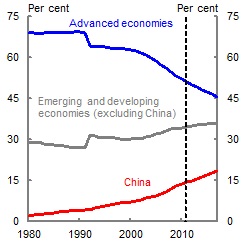
Percentage of US per capita incomes
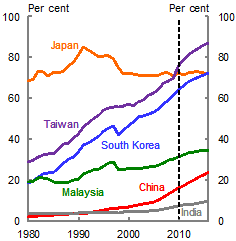
Source: IMF World Economic Outlook, April 2012.
Notes: GDP is in PPP dollars.
Rising incomes have in turn led to changing consumer tastes, such as increased demand for durable goods (such as cars and whitegoods) and a shift towards more expensive protein and nutrient-rich foods. This trend is set to accelerate with Kharas and Gertz (2010) estimating, based on present trends, that by 2021 there could be over 670 million middle class consumers in China, compared to only 150 million in 2010.4
China's economic development has coincided with rapid urbanisation, consistent with the experience of other earlier industrialising economies (Liu and McDonald, 2010). Economic reforms from the late 1970s set in train processes of industrialisation, capital deepening and productivity improvement that increased the demand for labour in urban areas, with workers attracted to cities by higher wages (Zhang and Song, 2003). The urbanisation rate increased rapidly from 19 per cent in 1980 to 50 per cent in 2011, and the United Nations (2012) projects that it will continue to rise steadily to 73 per cent by 2050. While China's urbanisation is rising rapidly, the share of the population residing in urban areas still remains below that of major advanced economies, and below the levels of other industrialising economies — such as South Korea and Malaysia — for the same level of per capita income (Chart 2).5
Chart 2: China's urbanising population
Urban share of population
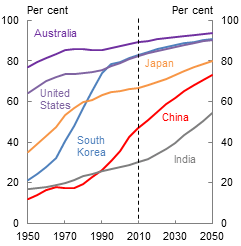
Urbanisation and GDP per capita
1960-20106
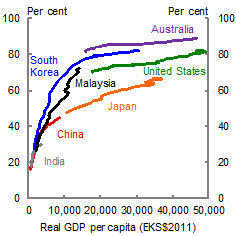
Source: United Nations World Urbanisation Prospects: The 2009 Revision; World Bank World Development Indicators 2011; The Conference Board Total Economy Database, January 2012.
Notes: GDP per capita is in US$2011 weighted using output at Èltetö-Köves-Szulc (EKS) PPP exchange rates.
China has industrialised quickly compared to other Asian economies, reflecting in part its bias towards industrial-led development in a centrally-planned economic system. The industry share of Chinese GDP has remained at or above 40 per cent for the past 35 years, at or higher than the levels seen in earlier industrialising economies, such as South Korea, Japan and the United States, at equivalent income levels (Chart 3) (BP, 2011a). However, it is likely that industry's share of GDP will fall as the Chinese economy continues to shift towards the production and consumption of services. The share of services in Chinese economic output has already risen from 20 per cent to 40 per cent since the early 1980s, broadly offsetting the declining share of agriculture (Chart 3).
Chart 3: China's industrial development
Industry share and GDP per capita
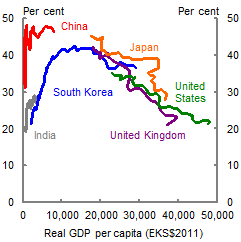
China's industrial development
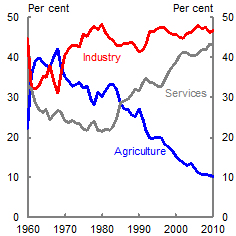
Source: World Bank World Development Indicators 2011; China CEIC Database, Australian Treasury; and the Conference Board Total Economy Database, January 2012.
China's rising energy demand
A direct consequence of China's rapid economic rise has been its rising demand for energy, which has had a significant impact on global markets for energy commodities. China's share of global primary energy consumption has risen from 8 per cent in 1990 to 20 per cent in 2010 (Chart 4). In particular, oil and coal demand has increased rapidly over the past two decades, and accelerated since 2000, reflecting China's rapid GDP growth and the structural shift in its economy towards energy-intensive heavy industry and infrastructure investment.
China's energy consumption is sourced predominately from coal, which accounts for 70 per cent of its total energy needs, compared to 30 per cent globally (Chart 4). Reflecting China's strong, energy-intensive economic growth, China's share of global coal consumption has risen to almost 50 per in 2010, up from 29 per cent in 2000.7 China's dependence on coal-powered energy largely stems from its significant indigenous coal reserves. China accounts for 13 per cent of the world's proven coal reserves (behind the US and Russia) and is currently the world's largest consumer and producer of coal, including metallurgical coal used in steelmaking (BP, 2011).
Chart 4: Chinese and global energy consumption
Share of world energy demand
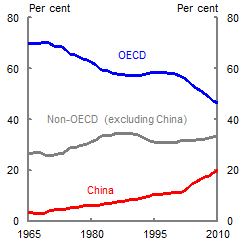
China's energy consumption 2010
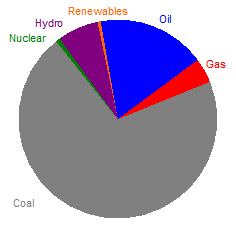
Source: BP Statistical Review of World Energy, 2011.
Note: measured in million tonnes of oil equivalent.
Chart 5: Chinese thermal and coking coal trade
Exports
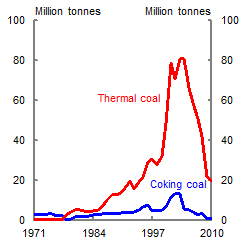
Imports
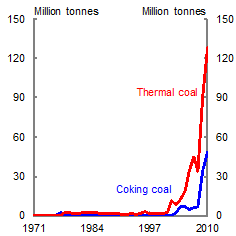
Source: International Energy Agency, Coal I
nformation 2011, OECD, Paris; and Australian Bureau of Agricultural and Resource Economics and Sciences.
Notes: Thermal coal is the sum of anthracite, sub-bitumous and other bitumous; coking coal refers to bitumous coal; 2010 figures are IEA estimates.
Recently, large government infrastructure-intensive stimulus has added substantially to coal demand for use in steel production and electricity generation. At the same time China has struggled to expand its coal mining and rail-transport infrastructure quickly enough to move coal from its large inland regions to industrialising coastal regions where coal demand has been strongest.8 In recent years the Government has also stepped up its efforts to alleviate the environmental impacts of coal production and consolidate the coal industry by closing smaller private coal mines, thereby slowing growth in domestic coal production. Therefore, despite abundant domestic supplies, China has become the world's second largest thermal and coking coal importer behind Japan, accounting for 16 per cent of global thermal coal imports and 18 per cent of global coking coal imports (Chart 5).9
Similarly, China's consumption of oil has surged over the past decade, increasing at an annual rate of 6.8 per cent, and accounting for nearly one-fifth of global oil consumption. Increased demand for transportation fuel, partly stemming from rising automobile ownership, as well as demand for petrochemical feedstocks and construction-related petroleum products (that is, bitumen, ashphalt, lubricants, and naptha), has led to increased oil consumption (Standard and Poor's, 2011). While China is a significant oil producer, sharply rising demand transformed China from a net oil exporter to a net importer, and subsequently the world's largest importer in 2008 (Chart 6). In 2009, China surpassed the US as the largest consumer of oil, as well as the world's largest automobile market.
Chinese natural gas consumption has also risen, albeit from a low base (Chart 6). While annual consumption growth has averaged 15 per cent over the past 10 years, the share of natural gas remains at only 3 per cent of China's energy mix. Currently, natural gas is largely used as feed stock in chemical fertilisers, but it is expected to play an increasing role in electric power generation and residential energy use. The increase in natural gas consumption has in part been driven by the Government's commitment to accelerate the transition from fossil fuels to cleaner energy sources, the discovery of gas fields and the construction of pipelines. The use of gas is being promoted by a system of price regulation, and facilitated by major developments of gas supply infrastructure — including pipelines from gas fields in Western China and nearby countries, and liquefied natural gas (LNG) import terminals. China has in place a policy objective to increase the energy share of natural gas to 8 per cent by 2015 in order to improve energy efficiency and energy diversification (Jacobs, 2011). This will make China the world's third largest gas market after Russia and the US (IEA, 2010).
China remains largely self-sufficient in natural gas as a result of large reserves in the remote north and western regions, although China's dependence on natural gas imports is expected to increase further in the medium term. China has only recently established itself as a buyer of LNG, after commencing imports in 2006. LNG now accounts for 12 per cent of total Chinese natural gas consumption, and Chinese imports account for 4 per cent of global LNG trade.
Chart 6: China's impact on global energy markets
Coal: contribution to global demand
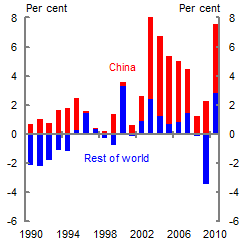
Oil: contribution to global demand
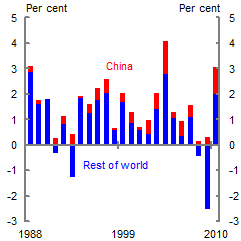
Gas: contribution to global demand
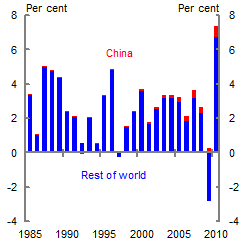
China oil consumption and production
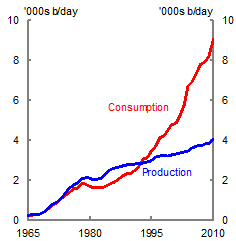
Source: BP Statistical Review of World Energy, 2011.
Notes: Coal refers to the sum of bituminous coal and anthracite (hard coal), and lignite and brown (sub-bituminous) coal.
Drivers of Chinese energy demand
China's future energy demand will depend upon the interaction of a number of trends, including the future trajectory of Chinese economic growth, the rate of urbanisation, trends in energy efficiency, the take up of alternative energy sources, and changes in economic structure — particularly the share of industry, and especially heavy industry, in China's future economic output.
To date the evolution of China's per capita primary energy consumption is broadly on par with Taiwan and South Korea at similar stages of their economic development (Chart 7). Growth in Chinese energy demand should slow as income per capita reaches around US$15,000 to US$20,000 as the Chinese economy transitions from heavy and energy intensive processes to lighter, higher value-added production (Cheung and Morin, 2007). In fact, Chinese per capita energy consumption will likely peak earlier than previous industrialising economies due to improvements in the energy intensity of GDP arising from the diffusion of new technologies, China's growing commitment to energy conservation and the prospect of higher real energy prices in coming decades.
Chart 7: Trends in primary energy consumption, 1965-2010
Per capita consumption
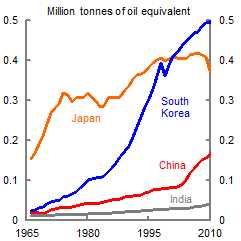
Per capita consumption and income
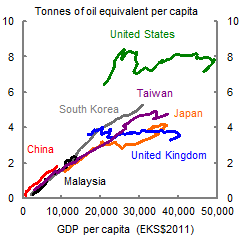
Source: BP Statistical Review of World Energy 2011; The Conference Board Total Economy Database, January 2012; and CIEC Asia Database.
After starting out with enormously high energy intensity per unit of GDP during the 1980s and 1990s, China experienced sharp declines in energy intensity (in PPP terms) as it converged with other recent industrialising economies and major advanced economies (Chart 8).10 These improvements reflected increased trade in energy and the rapid adoption of common technologies arising from intensified globalisation, as well as government regulations to shut down small inefficient power plants and a partial shift away from subsidized prices and central planning (Garnaut, Howes, and Jotzo, 2008). Recently declines in Chinese energy intensity have stalled as the share of heavy, commodity-intensive industry has risen, which, together with increased infrastructure investment, has seen energy consumption growth outstrip GDP growth from 2003 to 2004, and again in 2010 (Chart 8).
Chart 8: Trends in energy intensity of GDP, 1980-2010
Energy intensity of GDP
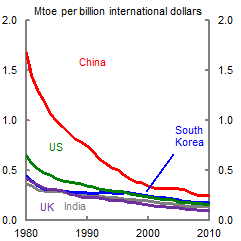
Energy consumption and GDP growth
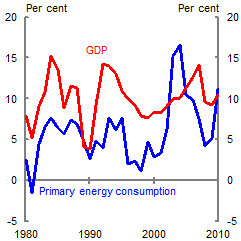
Source: BP Statistical Review of World Energy 2011 and IMF World Economic Outlook, April 2012; CEIC Database.
Notes: The left hand chart refers to energy intensity expressed as million tonnes of oil equivalent (mtoe) per billion international dollars in GDP in PPP terms. GDP growth in the right hand chart is specified in constant renminbi (RMB) prices.
In more recent years, China has also demonstrated a growing commitment to limit growth in its energy consumption by placing a higher priority on energy conservation and environmental protection. China's 12th Five-Year Plan covering the period 2011 to 2015 concentrates on energy efficiency and the use of cleaner energy sources. It includes targets to cut energy consumption per unit of GDP by 16 per cent by 2015 and to cut CO2 emissions per unit of GDP by 17 per cent as well as significant investments in the supply of renewables. China has also announced plans to introduce city and provincial level pilot carbon emission trading schemes in the near future and to develop an economy-wide scheme within the current decade.
Meanwhile global energy prices are at present expected to remain higher than those facing the previous round of industrialising economies, including South Korea and Taiwan, during their equivalent stages of development through the 1980s and 1990s (IEA, 2011).11 These factors should constrain future growth in energy demand and reduce the peak in China's per capita energy consumption vis-a-vis earlier industrialising economies.
Notwithstanding the potential for energy prices to remain high and pressure to meet environmental goals, prospects for future Chinese energy demand growth remain strong, given that China's per capita consumption of energy remains at only one-third of the average of Organisation for Economic Co-operation and Development (OECD) members. The International Energy Agency (2011) estimates that China's primary energy demand will rise by 2 per cent per annum to 2035, at which point China will account for 23 per cent of global energy demand. While gas and non-fossil fuels are expected to take on a greater share of China's energy mix in future decades, the transition in the fuel mix will occur slowly due to long asset lifetimes for existing energy infrastructure.
Looking ahead, China is expected to consume nearly 70 per cent more energy than the United States in 2035, be the largest oil consumer and oil importer, and will continue to consume nearly half of world coal production (IEA, 2011). Despite this, China's per-capita energy consumption will remain less than half the level of the United States in 2035 (IEA, 2011). China's electricity demand is projected to almost triple from 2008 to 2035, requiring capacity additions equivalent to 1.5 times the current installed capacity of the United States (IEA, 2010). Industry will still provide the largest single contribution to China's increased final energy demand in 2035, although industry's share of energy demand should decline as demand is increasingly driven by domestic consumption as a growing middle class generates increased demand for motor vehicles, electrical appliances, and other energy-related goods.
China's demand for industrial metals
China's rise as a manufacturing and industrial powerhouse has meant that its demand for industrial metals has surged. The construction of urban housing and the provision of urban infrastructure such as roads, railways, sewerage systems and electricity generation and distribution systems have generated sharply higher demand for metals such as copper, aluminium and steel over the past two decades. Meanwhile long-term investments in manufacturing capacity and infrastructure, particularly since China's accession to the World Trade Organisation (WTO) in 2001 and subsequent manufacturing boom, have also contributed to growing Chinese metals demand. The share of investment in GDP has increased from 35 per cent in 1980 to 49 per cent in 2010. As a share of fixed asset investment, infrastructure accounted for 27 per cent and manufacturing for 31 per cent. Residential investment has also become an important source of commodity demand, with its share of GDP having increased from 5½ per cent in 2004 to around 9 per cent in 2011 (Reserve Bank of Australia, 2012). The bulk of Chinese steel and copper is used in construction and infrastructure.12
Industrial metals embodied in Chinese manufactured goods — for both domestic consumption and export — are also an important source of metal demand. Manufacturing accounts for 40 per cent of Chinese GDP
, with at least a quarter of steel consumption directly used in manufacturing industries such as machinery, automobile and home appliances (Holloway, Roberts and Rush, 2010). These sectors are also a key driver of aluminium demand (World Bank, 2009).13 Moreover Roberts and Rush (2010) estimate that 10 per cent of the domestic supply of metals products are directly embodied in manufactured exports. Embodied metals exports may become an increasingly important share of domestic metals demand as China moves up the value chain towards more sophisticated manufactured goods for export (that is, machinery, automobiles and electronics).14
Infrastructure and manufacturing activity has resulted in metals demand sharply outpacing GDP growth. For example, China's consumption of copper and aluminium has increased by annual average rates of around 16 per cent over the past decade, in line with the rising urban share of China's population, and consistent with earlier processes of urbanisation among former industrialising economies (Chart 9) (Liu and MacDonald, 2010). With its rapid growth, intensive use and sheer scale, China has become the world's largest consumer of steel, aluminium, and copper, accounting for around 40 per cent of global consumption for each — a share two to three times larger than that of Japan or South Korea at the peak of their respective metals demand cycles (Chart 9).
Chart 9: Copper, steel and aluminium consumption
Copper — share of global consumption

Steel — share of global consumption
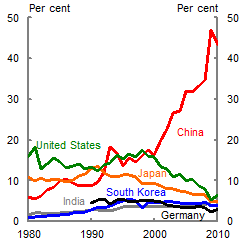
Aluminium — share of global consumption
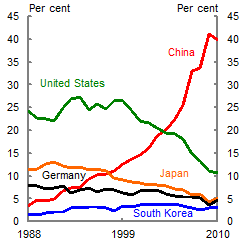
Chinese urbanisation and metals demand
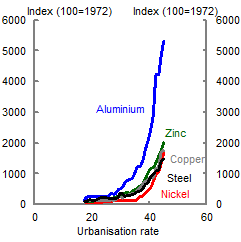
Source: ABARES Australian Commodities; BREE Resources and Energy Statistics 2011; World Steel Association Steel Statistical Yearbooks, various years; World Metal Statistics, various years; United Nations World Population Prospects: The 2010 Revision; United Nations World Urbanisation Prospects, The 2009 Revision.
Chinese metals production and trade
China's rapidly growing demand for industrial metals has been matched by its increased production. China has been the world's largest producer of steel for the past decade, producing almost half of the world's steel, three times as much the United States and Japan combined, owing to the emphasis on establishing steelmaking capacity since the early days of the country's push for industrialization. The steel industry is of strategic importance to China and has undergone major reforms over recent decades. Greater autonomy of state owned enterprises (SOEs) in the early 1980s, coupled with productivity improvements from China's opening up to foreign trade, which gave them greater access to advanced technologies, have supported rapid output growth.15
In fact, rising production has seen China become a net exporter of steel as well as aluminium ingots and alloys, despite closing some of its least efficient aluminium smelters in 2010 to meet energy efficiency and environmental targets.16 In contrast copper production continues to lag consumption, leading to rapidly rising imports equivalent to 40 per cent of world refined copper trade.17 China's increased metals production has in turn spurred rapid demand for intermediate inputs to refined metals production, including iron ore, metallurgical coal, alumina, and copper ore.
In particular, China's share of global iron ore consumption has more than doubled since the beginning of the 2000s to reach 52 per cent in 2010 (Liu and Grafton, 2011). Chinese iron ore production has been unable to keep pace with sharply rising demand as a result of transportation bottlenecks, low-quality ores and high marginal costs of production. Despite being the world's fourth largest iron ore producer (producing 15 per cent of global supply), China dominates global iron ore markets and accounted for around 70 per cent of global imports in 2009 (Christie, Mitchell, Orsmond and van Zyl, 2011).18 Around 40 per cent of its iron ore imports are sourced from Australia (amounting to an annual trade of around 280 million tonnes, or A$40 billion, in 2010-11).
Over the next decade, the scale of production of industrial metals will continue to increase as its industrial concentration grows and out-dated technologies are phased out, but it is unclear whether this will be sufficient to keep up with rising demand. In any case China is likely to remain dependent on imports for a number of key intermediate inputs to metals production.
Prospects for future Chinese metals demand
Measured in terms of metal consumption per unit of GDP, metal intensity has tended to increase in line with economic growth and as the structure of the economy shifts towards more metals-intensive manufacturing and heavy industry (McKay, 2008). The structure of Chinese economic growth has been particularly metals intensive, consistent with the earlier experiences of South Korea and Taiwan. Despite China's present dominance, per capita metals consumption and metals intensity of GDP, like per capita income, remain well below the levels of
advanced economies. Indeed Chinese per capita consumption of copper is broadly on par with that of where South Korea and Taiwan were at China's present level of per capita income, while aluminium and steel consumption are higher (Charts 10 to 12).
Chart 10: Trends in copper consumption per capita
Per capita consumption
1975-2010
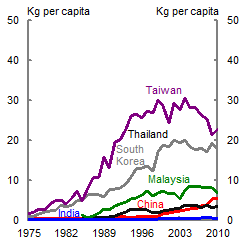
Consumption and GDP per capita
1963-2010
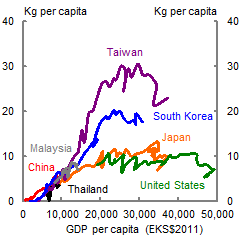
Source: ABARES Australian Commodities; BREE Resources and Energy Statistics 2011; United Nations World Population Prospects: The 2010 Revision and The Conference Board Total Economy Database, January 2012.
Chart 11: Trends in aluminium consumption per capita
Per capita consumption
1988-2010
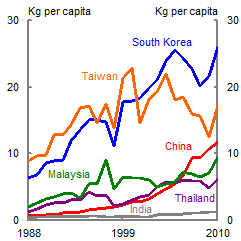
Consumption and GDP
1963-2010
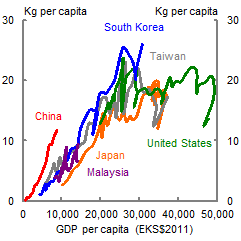
Source: ABARES Australian Commodities; World Metal Statistics, various years; BREE Resources and Energy Statistics 2011; United Nations World Population Prospects: The 2010 Revision and The Conference Board Total Economy Database, January 2012.
Chart 12: Trends in crude steel consumption per capita
Per capita consumption
1980-2010
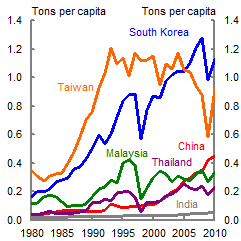
Consumption and GDP per capita
1971-2010
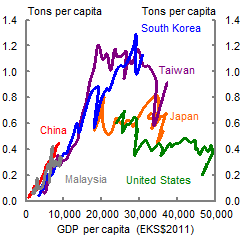
Source: ABARES Australian Commodities; World Steel Association Steel Statistical Yearbooks, various years; World Metal Statistics, various years; United Nations World Population Prospects: The 2010 Revision; The Conference Board Total Economy Database, January 2012.
Looking ahead, the underlying sources of Chinese metals demand are expected to remain strong, with construction, infrastructure, machinery and motor vehicle production projected to grow robustly for some time.19 Although China became the largest car market in the world in November 2009, it still has a low penetration rate of around 50 cars for every 1000 people compared to 500 cars for every 1000 people in the United States.
While China's specialisation in manufacturing is likely to persist, investment rates are projected to decline over time (the average life span of infrastructure investments exceeds 50 years) so China's metals intensity and per capita metals consumption is expected to stabilise and decline, as did the metal intensities of other Asian economies, such as Japan and South Korea, that followed a manufacturing and export-intensive development path. McKay, Sheng and Song (2010), for example, expect China's demand for steel to continue rising until China's GDP per capita reaches around US$15,000, a figure that will not be reached, according to the authors, until early 2020s if Chinese growth slows to 7 per cent annually. The authors forecast that Chinese steel demand will peak at around 700kg per capita (up from 400kg today), exceeding the levels seen during the industrialisation of Western Europe and North America, but lower than the peaks seen in Japan, South Korea and Taiwan.
China's demand for agricultural products
China is the world's largest agricultural economy, but so far, its economic rise has had a less dramatic impact on world agricultural markets, compared with its influence on global energy and metals markets. This, in part, reflects the fact that only 15 per cent of world food production is traded on intern
ational markets, the relatively more protected nature of agricultural trade and China's self-sufficiency goals.
China's impact on world agricultural markets varies significantly across commodities. With the world's largest population, China is the largest consumer of wheat, soybeans and rice, and the second largest consumer of corn (Chart 13). China has been a significant driver of increased global demand for soybeans, meat and dairy products. However, China's share of global wheat and rice consumption has declined in recent years.
Agricultural commodities are important to China not only for human consumption, but also as feed for livestock and as an input into energy production. Feedstock demand accounts for 70 per cent of Chinese corn consumption, 14 per cent of soybeans and 12 per cent of wheat. As the Chinese diet shifts towards more meat consumption, expanded livestock production will exert more pressure on Chinese demand for feed grains. Higher energy prices have also spurred growth in demand for feed stocks to support the production of biofuels, although biofuels industries account for a comparatively small share of agricultural consumption.20
Chart 13: China's share of world agriculture demand
Wheat
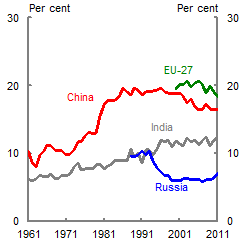
Rice
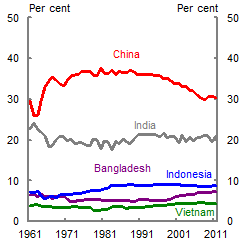
Soybeans
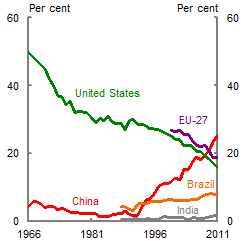
Corn
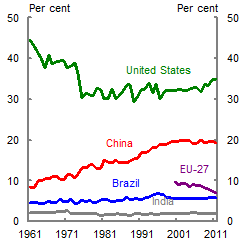
Source: United States Department of Agriculture Foreign Agricultural Service.
China's agricultural production
China is not only the world's largest agricultural consumer, but is also the world's largest producer of rice and wheat, and the second largest producer of corn (Chart 14). China also produces more than seven times the amount of fruits and vegetables as the US, reflecting China's comparative advantage in labour intensive agricultural production.
Chart 14: China's share of global food consumption and production, 2010-11
Consumption
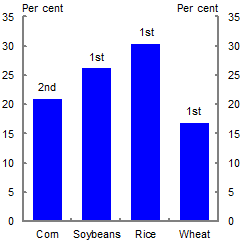
Production
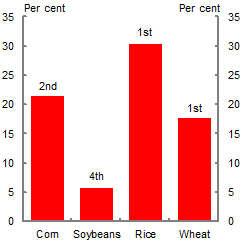
Source: United States Department of Agriculture Foreign Agricultural Service, Production, Supply and Distribution Database.
China's agricultural sector has changed dramatically since it began modernising following the introduction of reforms more than 30 years ago. From 1978, the commune system was reformed to provide greater autonomy to the collectives, and eventually replaced by a system where individual families leased land from the collectives, ensuring that almost all rural households had access to land and were, at minimum, food self-sufficient. As a result agricultural production rose sharply, poverty fell dramatically, and the level and quality of food consumption improved significantly, while rural industries expanded and absorbed a large part of farm labour (OECD, 2005).
China remains largely self-sufficient in most major agricultural commodities reflecting a primary strategic goal for Chinese policymakers — particularly following the widespread famines of the 1960s — and in the mid-1990s it devised a campaign to boost grain production.21 As China further integrated into the world economy, self-sufficiency goals were relaxed for many products, but leaders remained committed to achieving near self-sufficiency in the production of rice, wheat, corn and other grains. In December 2010, the Central government reiterated its policy of 95 per cent self-sufficiency in grains. This policy, coupled with support for rural incomes and promoting rural development, remains important.22
Achieving self-sufficiency in grains will, however, become increasingly difficult and costly with China's growing population, rising incomes, changing consumer tastes, concerns about the scarcity of water and arable land, and the impacts of climate change. China has less than 9 per cent of the world's arable land and only 6 per cent of the world's water supply but has more than 20 per cent of the world's population. The nutrient deficiencies of China's soils and the intensity of its farming practices make it the world's largest consumer of fertilizer (Potash Corp, 2010).23
These concerns have prompted the Chinese government to increase spending on agriculture and to prioritise investment in agricultural research and development.24 Implementing these policy objectives will, however, require policy makers to carefully balance the competing goals of increasing urbanisation while boosting agricultural production.
Chart 15: Historical trends in Chinese cereals production
Yields and area harvested
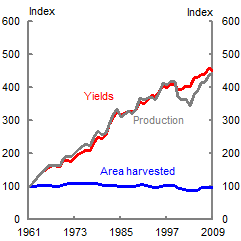
Average annual growth
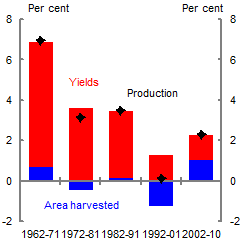
Source: FAO, Australian Treasury. Notes: left chart indexed to 1961-62.
Chinese grains production has risen more than fourfold in the past five decades, although yield growth has slowed over the past two decades (Chart 15). Meanwhile demand will continue growing strongly, albeit at a lower rate than seen over the past 40 years. Consequently the future trajectory of Chinese imports will depend on China's ability to continue increasing yields without commensurate increases in land under cultivation.
China's impact on global agricultural markets
With rising agricultural demand and slowing agricultural productivity growth, China's emergence is having an increasingly significant impact on global agricultural markets. Following China's accession to the WTO — which saw China reduce tariffs and end most of its remaining state monopolies on agricultural imports and exports — China's agricultural trade has grown rapidly. Over the past five years, Chinese agricultural imports have grown 23 per cent annually, with the US the largest supplier of agricultural products to China in 2010.25
Chart 16: Historical trends in agricultural trade
Global trade as share of global consumption
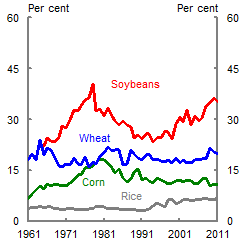
Chinese imports as share of global imports
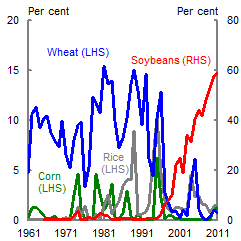
Source: United States Department of Agriculture Foreign Agricultural Service, Production, Supply and Distribution Database.
Notes: Global trade proxied by imports.
The small size of global markets magnifies China's presence, with only a small share of global grains traded internationally (Chart 16). For example, China has already become the world's largest importer of soybeans, accounting for nearly 60 per cent of global imports in 2009-10 and is projected to account for more than 70 per cent of global imports by 2014-2015 (Chart 16) (Standard and Poor's, 2011). China has also become a net importer of corn for the first time since 1995, reflecting strong demand for livestock feed.
The impact of rising incomes on food consumption patterns
Rising incomes are a key driver of increased food demand and shifting consumption patterns. Rapid economic growth in China has led to a rise in demand for protein and, partly as a result, the average number of kilojoules consumed on a daily basis in China has converged closer to levels seen in the United States and Europe (Chart 17).26 Greater access to markets, greater diversity of available food and refrigeration have also supported this shift.
Chart 17: Per capita food intake and income
Per capita daily calorie intake
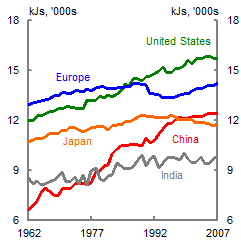
Per capita daily meat intake and income
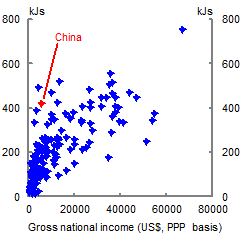
Source: FAO, World Bank World Development Indicators 2011, Australian Treasury; adapted from Rayner, Liang, Hall (2011).
Notes: kJs refers to kilojoules; data for right chart are cross-sectional and represent 158 countries in 2007.
Growth in per capita Chinese meat consumption has outpaced that of other industrialising Asian economies, accounting for around one-third of increased global demand over the past decade, while Chinese per capita milk consumption is also growing strongly. This increase in demand for meat and dairy is — through demands on land use and feed grains — contributing to broad based pressure on food prices. For example, one-third of all cropland is used to produce animal feed; and, on average, it takes 3kg of grain to produce 1kg of meat (United Nations Environmental Pr
ogramme, 2009).
Differences between rural and urban diets illustrate the impact of rising incomes in developing nations. While average Chinese incomes have risen dramatically over the past two decades, urban Chinese residents continue to earn on average three and a half times their rural counterparts.27 Reflecting rising incomes, urban diets have improved and are more diverse than those of rural citizens. Although urban and rural Chinese households have rapidly increased their consumption of pork, beef, mutton and poultry, and decreased their consumption of grains, urban residents on average consume significantly more meat and fruits, and fewer grains, than rural residents (Chart 18).28
Chart 18: Chinese food consumption among rural and urban residents, 2009
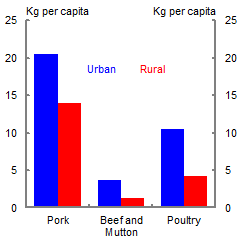
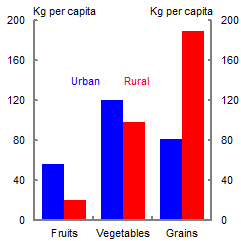
Source: National Bureau of Statistics of China, CEIC China database.
A growing population and rising incomes in China will sustain strong demand for agricultural commodities in future decades.29 With Chinese per capita income still low at around US$7500 in 2010 (PPP basis) — less than one-fifth of that of the US — rising incomes should continue to boost food demand for some time, especially for protein, dairy and soybeans. Moreover, significant income inequality across China means that the majority of the Chinese population continue to receive incomes well below this, which should further support growth in demand for higher-quality and protein-rich foods as their incomes rise.
With additional income to spend on food, demand will continue shifting from staple foods, such as grains, towards meat and horticultural products, such as fruit and vegetables, although rice is likely to remain a primary staple in Asian diets. Meanwhile declining human per capita consumption of grains such as wheat and corn could be offset by increased demand for use as feed stocks for livestock and biofuels production.30 These trends will only increase China's importance to global agricultural markets in the decades ahead.
Conclusion
China's rapid economic rise has had a significant impact on global commodity markets in recent years, and will be a key influence on future market developments. China has emerged as the leading consumer of a broad range of commodities — especially energy and industrial metals —and is a significant player in most major commodities markets, including agricultural commodities.
Strong economic growth, underpinned by commodity-intensive investment has sustained global commodities demand since the global financial crisis. With weak growth among advanced economies, China has taken an increasingly large share of global commodities consumption growth over the past five years. Although there will be short-term fluctuations around China's growth, and China faces significant medium-term reform challenges, the long term outlook for Chinese commodity demand remains strong as the process of urbanisation and industrialisation, and a growing middle-income class are set to continue for some time. Per capita consumption of key commodities, like per capita income, is still well below that of major advanced economies.
Economic rebalancing in China could have significant effects on future Chinese commodity demand, with significant implications for global markets. A more rapid shift from investment- to consumption- driven growth could slow the pace of metals and energy demand, although many consumption goods, such as automobiles, are still comparatively commodity intensive. Future Chinese commodity demand may be constrained by its already dominant position in some global commodity markets and the rate of growth of commodity supply.
In contrast, China's impact on agricultural commodity markets, has to date been more modest. China is yet to assume a large role in most global agricultural markets, with the exception of soybeans, despite its place as the world's largest consumer and producer of major grains such as wheat and rice. However, continued strong growth in food demand arising from rising incomes and a growing population, together with subdued supply growth, should see China increasingly utilise global markets as a major net food importer in the years to come.
Previous industrialising Asian economies provide some guide to China's future commodity demand. With rapid urbanisation, intense industrialisation and a growing role as a supplier of manufactured goods globally, China shares similar characteristics with other recently industrialised economies such as South Korea and Taiwan. However, unlike these economies, the sheer size of China's economy, its significant natural resource endowments and the comparatively low per capita incomes when China begun its rapid economic rise mean that China's development experience, and the trajectory of its commodity demand across energy, metals and agriculture, will ultimately prove unique.
References
APCO Forum, 2011, Policy Changes Affecting Foreign Food and Agriculture Companies in China, June, APCO.
Australian Bureau of Agricultural and Resource Economics, 2011, Australian Commodity Statistics 2011, Canberra.
BP, 2011a, Energy Outlook 2030, January.
BP, 2011b, Statistical Review of World Energy.
Cheung, C and Morin S, 2007, 'The Impact of Emerging Asia on Commodity Prices', Bank of Canada Working Paper No. 2007-55.
Christie, V, Mitchell, B, Orsmond, D, and van Zyl, M, 2011, 'The Iron Ore, Coal and Gas Sectors', RBA Bulletin, March Quarter, pp 1-7.
Coates, B, Devlin, W, and Woods, S, 2011, 'Commodity price volatility', Economic Roundup, Issue 1, pp 1-12.
Food and Agriculture Organization of the United Nations (FAO), 2009, The State of Agricultural Commodity Markets: High Food Prices and the Food Crisis: Experiences and Lessons Learned, Rome.
Food and Agriculture Organization of the United Nations, 2012, FAOSTAT, February, Rome.
Garnaut, R, Howes, S, and Jotzo, F, 2008, 'Emissions in the Platinum Age: the implications of rapid development for climate change mitigation', Oxford Review of Economic Policy, Vol 24, No 2, pp 377-401.
Golley, J, and Meng, X, 2011, 'Has China run out of surplus labour?', China Economic Review, Vol 22, No 4, December, pp 555-572.
Holloway, J, Roberts, I, and Rush, A, 2010, 'China's Steel Industry', RBA Bulletin, December Quarter, pp 19-25.
Hong Kong Monetary Authority, 2010, 'What Driv
es China's Food Price Inflation and How Does it Affect the Aggregate Inflation?', Working Paper 06/2010.
Hunt, W, 2011, 'Copper Advisory Service', Report No. 127, December.
International Energy Agency, 2007, World Energy Outlook 2007: China and India insights, Paris.
International Energy Agency, 2010, World Energy Outlook 2010, Paris.
International Energy Agency, 2011, Coal Information 2011, Paris.
International Energy Agency, 2011, World Energy Outlook 2011, Paris
International Monetary Fund, 2011, People's Republic of China: Spillover report for the 2011 Article IV consultation and selected issues, IMF Country Report No. 11/193, June.
International Monetary Fund, 2012, World Economic Outlook, April, IMF, Washington DC.
Kharas, H, and Gertz, G, 2010, The New Global Middle Class: A Cross-Over from West to East, Wolfensohn Center for Development at Brookings.
Liu, J, and Grafton, Q, 2011, 'Resources and energy prices: trends, volatility and demand shocks', Resources and Energy Quarterly, Vol 1, No 1, Bureau of Resources and Energy Economics, 2011, September.
Liu, J, and McDonald, T, 2010, 'China: growth, urbanisation and mineral resource demand', Economic Roundup, Issue 2, pp 57-72.
McKay, H, 2008, 'Metal intensity in comparative historical perspective: China, North Asia, the United States and the Kuznets curve', Global Dynamic Systems Centre, Working Paper No 6, September, Australian National University.
McKay, H, Y, Sheng and L, Song (2010), 'China's Metal Intensity in Comparative Perspective', in R Garnaut, J Golley and L Song (eds), 'China: The Next Twenty Years of Reform and Development', China Update Book Series, ANU E Press, Canberra, pp 73–98.
Organisation for Economic Co-operation and Development (OECD), 2005, Review of Agricultural Policies in China, May, Paris.
OECD-FAO, 2011, OECD-FAO Agricultural Outlook 2011-2020, OECD Publishing and FAO.
Potash Corp, 2010, Overview of Potash Corp & its markets 2010, October.
Rayner, V, Laing, E, and Hall, J, 2011, 'Developments in Global Food Prices', RBA Bulletin, March Quarter, pp 15-21.
Reserve Bank of Australia, 2012, Statement of Monetary Policy: February 2012, 'Box A: China's Residential Property Market', pp 14-16.
Roberts, I, Rush, A, 2010, 'Sources of Chinese Demand for Resource Commodities', Reserve Bank of Australia Research Discussion Paper 2010-08, November.
Shang, F, Zhao, B, Duan, S, and Zhou, Z, 2011, Sustainable Development of the Chinese Copper Market, International Institute for Sustainable Development.
Stage, J, Stage, J, and McGranahan, G, 2009, 'Is urbanization contributing to higher food prices?', Human Settlements Working Paper Series: Urbanization and emerging population issues — 1, International Institute for Environment and Development and United Nations Population Fund, August.
Standard and Poor's, 2011, The potential risk of China's large and growing presence in commodities markets, June.
Tu, J, 2011, 'Industrial Organisation of the Chinese Coal Industry', Program for Energy and Sustainable Development Working Paper No. 103, Stanford University, July.
United Nations, 2011, World Population prospects: The 2010 Revision, Database accessed 15 February 2012 at the United Nations, Department of Economic and Social Affairs website.
United Nations, 2010, World Urbanisation prospects: The 2009 Revision, Database accessed 15 February 2012 at the United Nations, Department of Economic and Social Affairs website.
United Nations Environmental Programme, 2009, The environmental food crisis — the environment's role in averting future food crises, February.
United States Department of Agriculture Foreign Agricultural Service, Production, Supply and Distribution Database, Database accessed 15 February 2012 at the United States Department of Agriculture, Foregin Agricultural Service website.
US International Trade Commission, 2011, China's Agricultural Trade: Competitive Conditions and Effects on US Exports, March, US International Trade Commission, Washington DC.
Wen Jiabao, 2011, Report on the Work of the Government, delivered at the Fourth Session of the Eleventh National People's Congress, delivered 5 March.
World Bank, 2007, World Development Report 2008: Agriculture for Development.
World Bank, 2009, 'Box 2.5 Understanding the Rise of Chinese Metals Intensities', Global Economic Prospects 2009: Commodities at the Crossroads, The World Bank Group.
World Bank, 2011, World Development Indicators 2011, The World Bank Group.
Yu, Y, 2011, 'Identifying the linkages between mining commodity prices and China's economic growth — implications for Latin America', IMF Working Paper WP/11/86, IMF, Washington.
Zhang, K and Song, S 2003, 'Rural-urban migration and urbanisation in China:
Evidence from time-series and cross-section analyses', China Economic Review, No 14,
pp 386-400.
1 The authors are from International and G20 Division, the Australian Treasury. This article has benefited from comments and suggestions provided by Sarah Woods, Julia Minty, Bill Brummitt, Michael Callaghan, Hui Yao, Veasna Kong, Dougal Horton, Alison Keys and James Holloway. The views in this article are those of the authors and not necessarily those of the Australian Treasury.
2 Many investments in supply were postponed due to the global financial crisis, and many projects initiated prior to the crisis have yet to add to existing capacity, due to the lags in translating the investment into new production, particularly in energy and mining. For example, while investments by 25 leading coal companies rose by about 4.5 per cent to US$12 billion in 2009, this rise was much less compared to 2008, when it rose 18 per cent. See International Energy Agency (2010) and World Energy Outlook (2010).
3 According to the Food and Agriculture Organization of the United Nations (FAO), the rate of growth in agricultural production is expected to fall to 1.5 per cent per annum between now and 2030, and to 0.9 per cent between 2030 and 2050, as compared to 2.3 per cent since 1961. See FAO of the United Nations (2009).
4 The authors define the global middle class as those households with daily expenditures between $10 and $100 per person in purchasing power parity terms. The lower bound is chosen with reference to the average poverty line in Portugal and Italy.
5 The future direction of the Chinese hukou system, whereby movement of citizens between urban and rural areas is managed, will significantly influence the pace of future Chinese urbanisation (Zhang and Song, 2003; Golley and Meng, 2011).
6 Data for Japan refer to the period 1965-20
10 only.
7 Around one-half of China's coal is used in the electricity sector, with a further quarter used directly in industrial sectors including the production of steel and pig iron. Chinese electricity production has increased fourfold in the past fifteen years (IEA, 2011).
8 The northern provinces of Inner Mongolia, Ningxia and Shaanxi together account for 70 per cent of total recoverable coal reserves, well away from coal demand centres in the east and south (Tu, 2011).
9 Coal is the least globalised of the world's major energy sources, with only 15 per cent of production traded internationally.
10 China's energy intensity is much higher and has declined at a slower rate if market exchange rates are used to compare economies, reflecting the relatively smaller comparative size of the Chinese economy in market-exchange rate terms, compared to PPP terms.
11 Global energy prices remained below their long-term average in real terms from the mid-1980s through to 2000, based on the IMF's international financial statistics energy price index, deflated by the United States GDP deflator (Coates, Devlin and Woods, 2011).
12 Construction accounted for 55 per cent of Chinese steel consumption in 2008, followed by machinery (18 per cent), automobiles (6 per cent), rail, shipping and fuel (5 per cent), and home appliances (2 per cent) (Roberts and Rush, 2010). As of 2010, 56 per cent of copper was used in construction and infrastructure (Hunt, 2011).
13 Alternative estimates from China's official input-output tables suggest that, in value terms, manufacturing may account for a somewhat larger share of steel consumption than these figures imply (Roberts and Rush 2010).
14 This is particularly the case for non-ferrous metals such as copper and aluminium, which have a higher value to weight ratio and are therefore more likely to be traded.
15 See Holloway, Roberts and Rush (2010) for discussion on the growth of the Chinese steel industry over recent decades.
16 Much of China's aluminium is produced at small and midsize smelters that are major employers in their regions, and so they are unlikely to close permanently (Standard and Poor's, 2011).
17 Since 1990, China's demand for copper ore has increased at an average annual rate of nearly 14 per cent, with imports accounting for around two-thirds of copper ore used in China (Yu, 2011). As the global supply of raw copper materials is limited, the secondary copper market plays a key role in the supply of raw copper materials in China, supplying around 30 per cent of total Chinese copper consumption.
18 Chinese production, consumption and trade figures for iron ore are adjusted to correspond to the world average iron content.
19 The prospects for strong domestic copper demand are promising, given the long term growth potential of the energy, real estate, automobile and home appliance sectors (Shang, 2011).
20 Biofuels are expected to account for only 2 per cent of all transport fuels in China by 2030, reflecting the limited agricultural land for feedstock crops given concerns about the security of food supplies (IEA, 2007).
21 In the mid-1990s, the ‘Governor's Grain Responsibility System' (also known as the obligatory system) was introduced to ensure adequate domestic supply of grains and arose out of concern over securing food supply. Provincial governors were responsible for their province's self-sufficiency in grains, irrespective of local farming conditions.
22 At the December 2010 Central Economic Work Conference, policymakers agreed to increase subsidies for agricultural production, gradually raise minimum grain prices and boost investment in major grain-producing areas. Under the 12th Five-Year Plan China plans to deepen rural reform, increase funding for agriculture and farmers and direct more spending towards agriculture and rural areas.
23 Prices for nitrogen fertilisers and other farm chemicals are closely related to the crude oil price, so rising oil prices translate into increasing production costs (FAO/OECD, 2011).
24 See APCO, 2011.
25 The US is a major producer of soybeans, and as such has benefitted greatly from trade with China (US International Trade Commission, 2011).
26 The Hong Kong Monetary Authority estimates that a 10 per cent increase in overall real household spending per capita is associated with a 1.1 per cent increase in meat consumption in the US, compared with an 11.5 per cent increase in China. See Hong Kong Monetary Authority (2010).
27 In 2010, per capita incomes in urban Chinese households averaged RMB 21,033 compared to RMB 5,919 among rural residents.
28 While shifting to urban areas can lead to a more diversified diet as citizens gain access to a wider range of foodstuffs, shifting patterns of food consumption towards protein are driven more by the coincident increase in incomes than the process of urbanisation itself. See Stage, Stage and McGranahan (2009).
29 Population growth can be expected to boost food demand over the coming decade, but at a slower pace than previously. China's population growth is expected to slow to an average of 0.2 per cent per annum through to 2030, compare to average population growth of 0.8 per cent over the past two decades (United Nations, 2011).
30 Roughly two-thirds of global wheat production is currently used for direct human consumption, but growth from this segment of demand is anticipated to slow down through to 2020 (OECD/FAO, 2011).